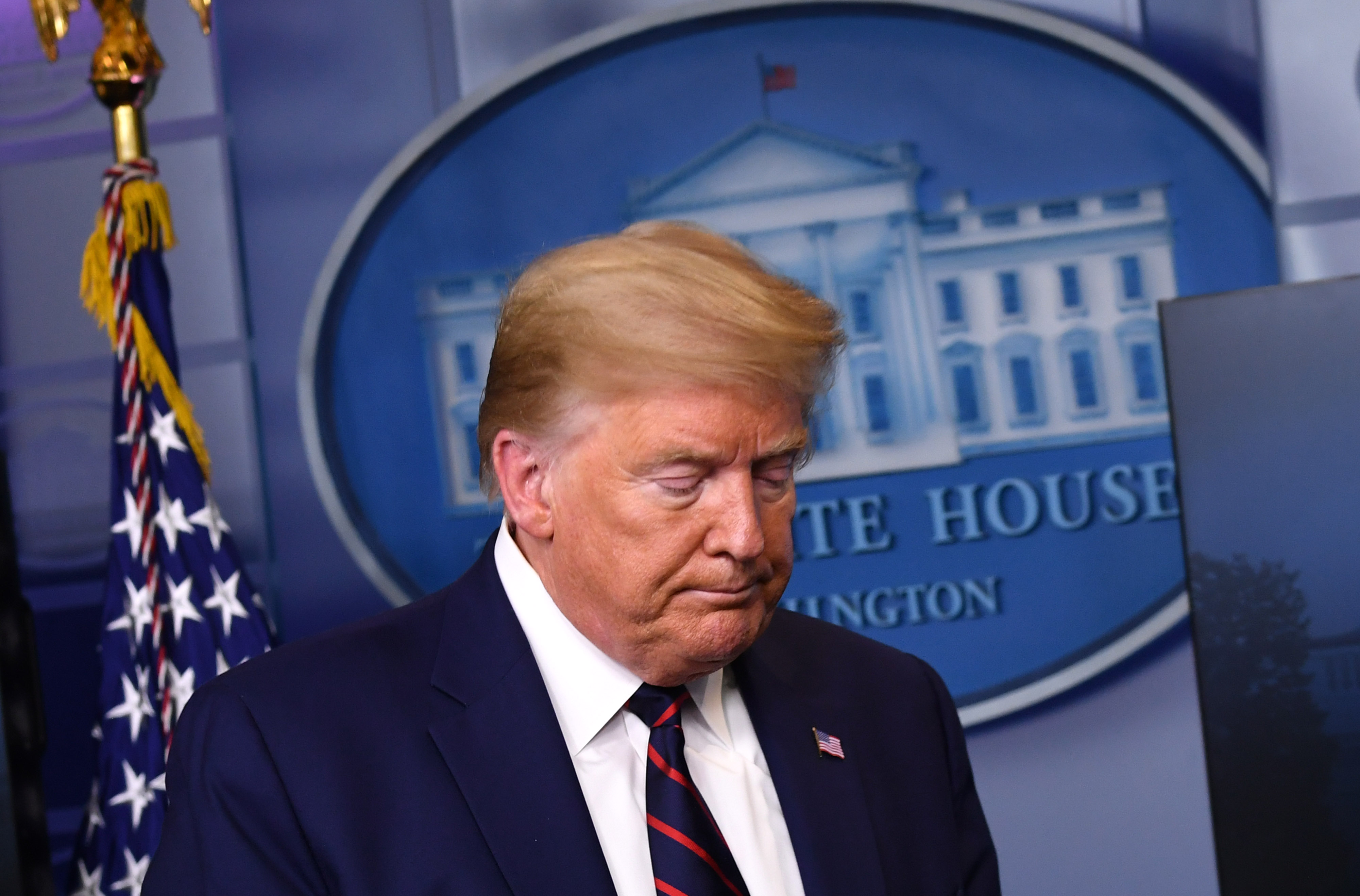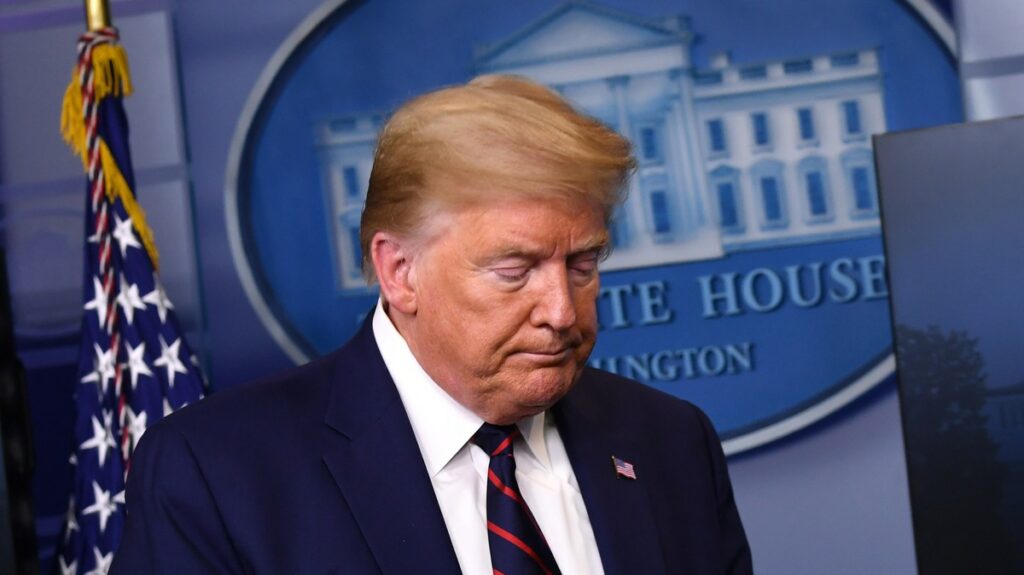[ad_1]

Now, after years of overstating his own physical fitness and months of severely downplaying the threat of the coronavirus, Trump’s second campaign — and the fate of the country — rests on asking Americans to take his word about his health.
Trump’s late-night tweet announcing his positive COVID-19 diagnosis threw his campaign and presidency into unpredictable chaos with just a month left before Election Day. The news signaled a reckoning, as Trump’s hostile relationship with the truth has profoundly damaged public confidence in the president’s word.
The official line from the White House: Hey, he’ll be just fine!
“The president does have mild symptoms,” Trump’s Chief of Staff Mark Meadows told reporters outside the White House Friday morning. “I’m optimistic that he’ll have a very quick and speedy recovery.”
Meadows cast Trump as working away in the White House residence, handing out to-do assignments, and focusing on the economy — as if his stunning diagnosis with the disease he’s played down for months was no big deal. Trump had already canceled in-person events, but the White House schedule still had him joining a phone call about seniors who’d been impacted by the coronavirus. Vice President Mike Pence stepped in instead — but reporters weren’t informed of the change.
But Meadows failed to address why Trump continued on to a campaign fundraising event in New Jersey on Thursday even after the White House knew that a top aide who’d been in contact with him, Hope Hicks, had tested positive for the virus.
The White House didn’t announce Hicks’ diagnosis. Bloomberg News broke the news. The lag left journalists and pundits wondering what other important updates the administration might be holding back. Trump reportedly skipped the only item on his calendar Friday. In a move loaded with irony, the 74-year-old Trump instead let Vice President Mike Pence take his place on a planned call about supporting “vulnerable seniors” during the pandemic.
The fluid situation leaves Americans waiting on edge for news about a president who has spent years undercutting his own credibility on his health, the safety of the nation, and pretty much everything else.
Trump started his campaign with a lie about his health
Trump’s first press release about his own health, attributed to a physician named Harold Bornstein in December 2015, sounded like a transcript of Trump making stuff up — because that’s what it was.
The letter hailed Trump as a kind of superman, with “extraordinary” physical health and stamina, “excellent” cardiovascular status, “astonishingly excellent” blood pressure, and tests that show “only positive results.”
Bornstein later admitted it was all nonsense.
“He dictated that whole letter. I didn’t write that letter,” Bornstein told CNN. “I just made it up as I went along.”
In January 2018, another doctor gave Trump a similarly over-the-top assessment.
Then-White House physician Ronny Jackson hailed Trump’s “excellent” health in similarly Trumpy language. Jackson suggested Trump’s poor habits — including his penchant for Diet Coke and red meat — seemed to be counteracted by good genetics.
“Some people have great genes,” Jackson said.
The White House hasn’t been straight with reporters about Trump’s health in other key moments, either.
When Trump made an unscheduled visit to Walter Reed medical center last year, White House spokeswoman Stephanie Grisham claimed it was because he had a “free weekend” and said he underwent “a quick exam and labs,” while refusing to elaborate on what tests he’d undergone.
The New York Times’ Michael Schmidt later reported in his book that Vice President Mike Pence had been put “on standby to take over the powers of the presidency temporarily if Trump had to undergo a procedure that would have required him to be anesthetized” on that day. Pence later said he didn’t recall having been told to be put on standby, claiming “there was nothing out of the ordinary” about the visit.
Trump later tweeted that people were lying that he had “suffered a series of mini-strokes” — something that no one had reported. His doctor backed him up, saying in a statement that he hadn’t had any strokes. It’s still unclear what exactly prompted Trump’s last-minute trip to the hospital.
On Friday, Meadows refused to answer questions about exactly when the White House learned that close, longtime aide Hope Hicks tested positive for coronavirus, or to give clearer specifics about what Trump’s “mild symptoms” might actually be.
Trump’s record of truth on the coronavirus is even worse. He publicly downplayed the risks of the virus for months and decried efforts by states to shut down activity to try to mitigate its spread, even as he privately admitted early on how dangerous the disease might be.
In late January, as the first confirmed cases of COVID were identified in the U.S., Trump promised that “we have it completely under control.”
On Feb. 7, he told Bob Woodward that the virus was “deadly stuff” and “more deadly than even your strenuous flus.”
But just days later, on Feb. 10, he proclaimed publicly that it would likely go away “in April with the heat.” On the 28th, Trump declared that the coronavirus was just “going to disappear.”
A few days later in early March, Trump dismissed early World Health Organization’s estimates that COVID-19 had a 3.4 percent death rate, calling it a “false number” during a Fox News appearance.
On March 10, he said “it will go away.” The next day, Trump said that for “the vast majority of Americans, the risk is very, very low.”
When the CDC recommended all Americans wear masks in early April, Trump said “it’s only a recommendation,” and that he was “choosing not to do it.” He refused to wear a mask at any point until July, and since then has only worn one sparingly.
On March 19, Trump told Woodward that “I wanted to always play it down… I still like playing it down, because I don’t want to create a panic.”
A few days later, he said he wanted the country “opened up” by Easter.
He continued to downplay the virus’s risks throughout the spring and summer surge, before pivoting to months of claims that he’d done an excellent job of containing the virus even as the death toll in the U.S. ticked past 200,000 people, the highest per capita death toll in the world.
Part of that argument has been misleading claims that the COVID rate had climbed only because more testing was being done, even as the U.S. continued to lag behind other countries in its testing regime. In mid-July, Trump downplayed the massive spike in COVID cases by arguing that it was because of increased testing — and that many positive tests were “young people that would heal in a day.” Less than two weeks ago, Trump declared that the virus “affects virtually nobody” except seniors.
A recent study from Cornell University of 38 million English-language articles found that Trump is the “single largest driver” of misinformation about the coronavirus, with 38 percent of all coronavirus misinformation it analyzed tracing back to his claims.
White House Chief of Staff Mark Meadows told reporters Friday morning that Trump has “mild symptoms” and was feeling “very energetic,” but declined to discuss any particular treatment Trump might be undergoing, promising a later update from Trump’s doctors.
And while he said that the White House found out about Hicks’ positive test on Thursday just as she was preparing to leave on Marine One with President Trump. But he didn’t address why Trump continued on to an indoor fundraising event at his Bedminster, N.J. golf club after they had that information.
And Trump’s onstage debate with Vice President Joe Biden put his rival at risk. Trump’s team refused to wear masks at the Tuesday debate. Biden has tested negative and decided to continue on with his scheduled campaign events. But it’s unclear what impact the White House outbreak will have on future scheduled debates.
And until it’s clear exactly how sick Trump is, it’s an open question how much involvement he’ll have in running the country on a day-to-day basis — not to mention whether he’ll be physically fit for another four years in office.
With just over one month to Election Day, how Trump fares as he battles the coronavirus will be a crucial issue. And he and the White House have proven you can’t take them at their word for how he’s doing. That leaves the U.S. in a precarious situation heading into a monumentally consequential election.
Cover: U.S. President Donald Trump leaves a Coronavirus Task Force news conference at the White House in Washington, D.C., U.S., on Thursday, April 2, 2020. Trump tested negative again for the coronavirus and has no symptoms, a White House doctor said. Photographer: Kevin Dietsch/UPI/Bloomberg via Getty Images
[ad_2]
Source link

